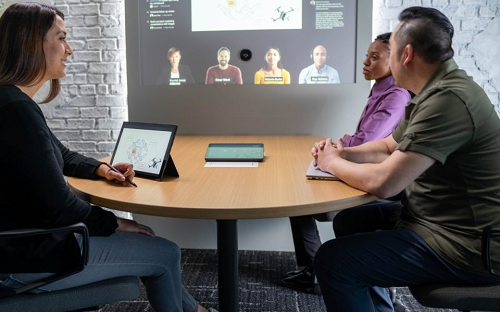As organizations begin to transition back to the office and adopt a flexible, hybrid work model, Microsoft is hoping to lead customers through that change and offer meeting room options to meet a variety of needs.
In addition to releasing a hybrid work playbook, the company released a short video detailing its vision for the future of meeting rooms and has included detailed descriptions of the type of audiovisual devices optimized for each kind of room.
The guide and a video are somewhat of a marketing tool for Microsoft Teams Rooms, but they could also offer some guidance for audiovisual integrators who want to be part of the hybrid work solution.
According to Microsoft, the company envisions meeting rooms of three different sizes: a smaller room called the Focus Room, a mid-size room, called the Medium Space and a larger room appropriately named the Large Space.
Microsoft envisions more intimate environments that better connect in-person and remote users in a more unified experience with a larger screen that provides a life-size image of a user on the other end. This also includes an eye-level camera, spatial audio and meeting notes at the forefront.
The rooms also include premium microphones hidden in the ceiling, intelligent cameras to bring participants into view, and spatial audio to help establish a connection with remote participants.
Read Next: Microsoft Is Experimenting With Hybrid Work Tools As Company Begins Transition
Here’s a list of what Microsoft envisions for rooms of each size:
The Focus Room includes:
- A Teams panel
- A 60-inch display
- A Microsoft Teams Rooms system
- An Intelligent speaker
- A 180-degree camera
- A content camera
A Medium Space includes:
- A Teams Panel
- 2 70-inch displays
- A Microsoft Teams Rooms system
- A ceiling tile microphone and DSP
- Two speakers
- A room tracking camera
- A content camera
A Large Space includes:
- A Teams panel
- Two 70-inch displays
- A Microsoft Teams Rooms system
- A ceiling tile microphone and DSP
- Two speakers
- An Active speaker tracking camera
- An 85-inch Surface Hub on the side of the room
In addition to the video and guide, Microsoft CEO Satya Nadella published a long post on LinkedIn detailing the company’s hybrid work practices.
He says in large rooms, the company is using Teams Rooms with high-quality AV devices to ensure everyone on the call can participate as if they were in the room.
“We’re taking the same approach to our smaller focus rooms, too,” Nadella wrote. “We are installing cameras at eye level for participants to maintain eye contact, and will incorporate spatial audio so voices come from the specific person speaking in the gallery view.”
“We want to ensure those joining remotely are always first-class participants. Smart cameras in conference rooms will allow them to see individual videos of in-room participants in Teams, to keep the connection as authentic as possible. And, of course, they have the same access to content and presentations as people in the room.”










